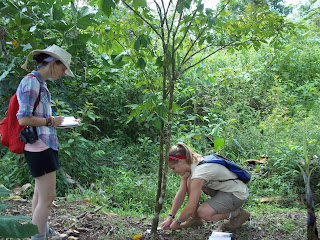Spring break is officially over. I spent 10 days sleeping in 8 different places, traveling to 4 different cities through a distance of 186 miles across the country, getting well acquainted with several bus terminals, and seeing a whole bunch of wildlife.
The first day, Ryan and I stayed in San Jose just long enough to have some gallo pinto and fruit, and then headed to the Terminal Caribe to take a bus to Cahuita.
Our cabin in Cahuita was smack dab in Howler territory. We got to see some majestic little primates running around the palms outside, and also got a free alarm clock when we woke up to their soothing voices at 4:45 in the morning. In reality, their howls sound like this horrible, gutteral roaring that sounds like it comes from some chimaerical beast, and not from some sweet looking monkey.
The white-faced capuchins were even cuter, although to add to the pickpocketing climate of Limon, my friend got robbed by a monkey! Ryan and I didn't experience such monkey hostility aside from the howlers barking furiously during prime sleeping hours, but we did catch some great monkey moments outside of our cabin, like this guy enjoying some fruit that he may or may not have pilfered from the fruit vendors
Another wonderful mammal we encountered was the sloth. Sloths are pretty freakin cool. We saw them at the Cahuita Sloth Sanctuary - a place where people rehabilitate injured sloths or sloths abandoned by their mothers. They are actually ectothermic (not "warm-blooded"), as our tour guide was telling us. I've never heard this before, but it makes sense - they are constantly near the sun, and can't need much energy when they sleep 15 to 18 hours per day.

The tour guide then proceeded to prove to me that yes, in fact, I had died and gone to heaven, when we took a tour of the sloth nursery, full of baby Bradypodidae! Many of these sloths were a distinct burnt orange, henna-like color, and our guide informed us that they had mange. Instead of using typical veterinary mange treatment, as is used for dogs but is damaging to sloths, at the Sloth Sanctuary they use achiote to kill the parasites! I guess examples of traditional plants don't stop outside of our ethnobiology classes (achiote is that orange-colored plant with the dye that some indigenous groups paint on their faces).
Feeding time for the baby sloths!
Puerto Viejo is full of expats from the US, Germany, Switzerland, and England. It had a lot of funky restaurants, including Bread and Chocolate, a place with lots of organic (and vegan!) ingredients and delicious whole wheat pancakes and waffles that we had for dinner with fruit, honey, and chocolate sauce. The beach was also beautiful. It was like standing in a reef-filled beachy bath
Although we've been warned about how dangerous the Limon province is (where Cahuita and Puerto Viejo are), I did feel safer there than in San Jose...there was no barbed wire on every building, for one thing. However, some of my friends had some sketchy experiences, and the locals in Cahuita were definitely ready to rip off or shortchange tourists at any opportunity, so I'm glad that we didn't wear out our welcome on the Caribbean coast.
Not to mention Limon has the most cases of malaria and of lymphatic filariasis, some more diseases to become hypochondriacal about with the myriad bug bites we've collected. I'm reluctant to post about this, because last time I mentioned that everyone was getting sick, I got feverish shortly thereafter, but I'll go ahead and push my luck. Four people in my group so far have suffered from intestinal/diarrhoeal problems (likely from the water in Panama - we were brushing our teeth in the sink when tadpoles came out), and I feel like these next few weeks will be very telling about our effective treatment of water from Limon.
Monteverde was a breath of fresh air (literally) from the beachy humidity and the threat of getting some diarrhoel disease from the Limon water. Everyone was so friendly and welcoming there too, and the environment is very crunchy/outdoorsy, geared towards travelers and backpackers.
We spent our St. Patty's day appropriately, surrounded by greenery on a canopy zipline tour.
Overall, it was a phenomenal experience - who needs coffee when instead at 10 in the morning you can fall from a Tarzan swing (a rope to your harness where you literally just swing like Tarzan on a vine) and zip through the whole jungle on cables?
But it turns out that we did need coffee. Our next stop was the Don Juan coffee plantation tour (the closest thing to a brewery tour in Monteverde), where we learned about the different layers and functions of the coffee berry, how the beans are collected, processed and dried, and how the different size and presentation of the bean determines whether it will be whole bean coffee, ground coffee, or candles and candies.
To cap it all off, we found a rainbow - although we couldn't see the pot of gold at the end.
All in all, spring break was a wonderful chance to take advantage of being a tourist, although as my mom would say, my money was burning a hole in my pocket. As relaxing as this week was, I am really looking forward to hopping on that Turismo bus, being told where we're going and where we're staying, and getting hot meals put in front of us three times a day.
I have spent 63 days in Costa Rica so far. Only 42 more left! What a crazy thought.
Hasta luego!
Anya





































